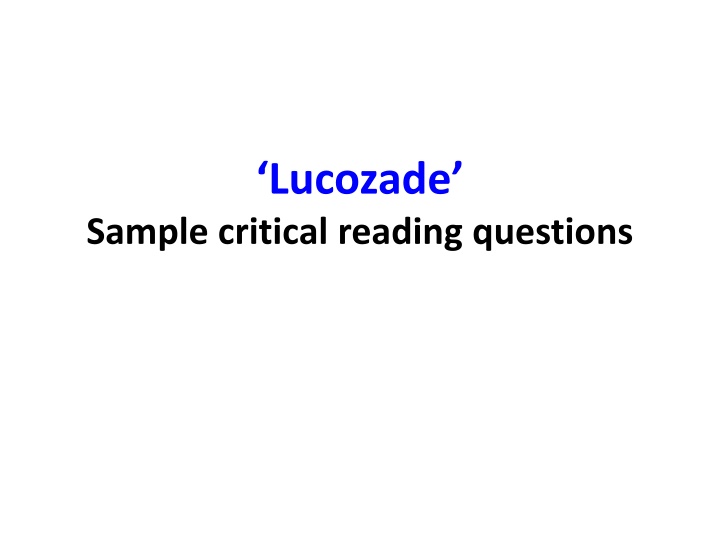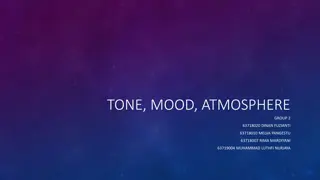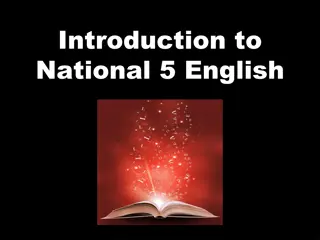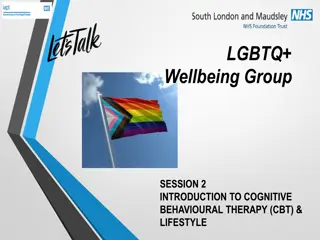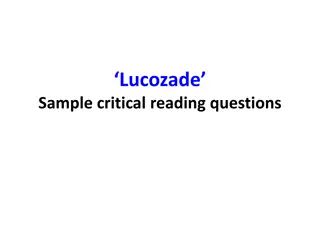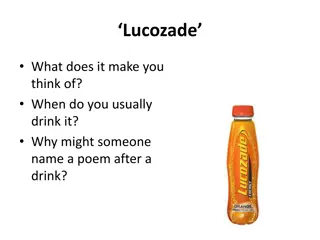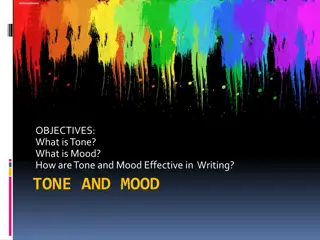Critical Reading Analysis: Language and Mood in "Lucozade
The critical reading questions delve into how the language and imagery in the poem "Lucozade" create a solemn mood, depict the speaker's mother's illness, convey the mother's feelings about being in the hospital, and highlight a significant shift in the mother's mood. Through thoughtful analysis of specific stanzas, the questions explore the emotional depth and narrative progression of the poem.
Download Presentation

Please find below an Image/Link to download the presentation.
The content on the website is provided AS IS for your information and personal use only. It may not be sold, licensed, or shared on other websites without obtaining consent from the author.If you encounter any issues during the download, it is possible that the publisher has removed the file from their server.
You are allowed to download the files provided on this website for personal or commercial use, subject to the condition that they are used lawfully. All files are the property of their respective owners.
The content on the website is provided AS IS for your information and personal use only. It may not be sold, licensed, or shared on other websites without obtaining consent from the author.
E N D
Presentation Transcript
Lucozade Sample critical reading questions
1. How does the language of the first stanza create a solemn mood? My mum is on a high bed next to sad chrysanthemums. Don t bring flowers, they only wilt and die. I am scared my mum is going to die on the bed next to the sad chrysanthemums. This tells us that the speaker is sad, not the flowers. They are stereotypical hospital flowers , suggesting illness, repeated to emphasise the speaker s fear. sad chrysanthemums wilt and die The flowers suggest death they will fade and lose vitality, like people who are ill. I am scared my mum is going to die This adds to the melancholic, solemn mood she is afraid of losing her mother to illness.
2. How does the language of stanzas 14 convey the idea that the speaker s mother is very ill? wilt and die the flowers, the mother will die. I am scared my mum is going to die - suggestion that she is terminally ill. She nods off and her eyes go back in her head. lack of energy / fading of vitality. suggests that, like My mum is on a high bed next to sad chrysanthemums. Don t bring flowers, they only wilt and die. I am scared my mum is going to die on the bed next to the sad chrysanthemums. She nods off and her eyes go back in her head. Next to her bed is a bottle of Lucozade. Orange nostalgia, that s what that is, she says. Don t bring Lucozade either, then fades. suggests a The whole day was a blur, a swarm of eyes. Those doctors with their white lies. Did you think you could cheer me up with a Woman s Own? Don t bring magazines, too much about size. fades continues the idea of light going out / vitality ebbing. blur suggests things are indistinct, unclear, her senses are impaired / fading. My mum wakes up, groggy and low. she seems to be drifting in and out of consciousness, she is confused and fed up. My mum wakes up, groggy and low. What I want to know, she says, is this: where s the big brandy, the generous gin, the Bloody Mary, the biscuit tin, the chocolate gingers, the dirty big meringue?
3. How does the language of stanza 3 convey the mothers feelings about being in hospital? The whole day was a blur, a swarm of eyes. Those doctors with their white lies. Did you think you could cheer me up with a Woman s Own? Don t bring magazines, too much about size. a swarm of eyes she feels objectified, gawped at. This shows her irritation and feelings of passivity and conveys the image of visitors, doctors, nurses all gathering round her in a suffocating manner. recalls doctors white coats and suggests the idea that she thinks the doctors are dealing in half truths / medical euphemism and keeping information from her. She seems to want to confront her illness head on. white lies cheer me up suggests that she is fed up of being in hospital.
4. At line 15, the mothers mood changes. How is this change conveyed in the language or ideas of this stanza? My mum wakes up, groggy and low. What I want to know, she says, is this: where s the big brandy, the generous gin, the Bloody Mary, the biscuit tin, the chocolate gingers, the dirty big meringue? My mum wakes up, groggy and low the stanza begins in a sombre manner with the mother waking up, perhaps after an operation. despite her fragile state, she speaks with a commanding tone. What I want to know, she says, is this: this is a pivotal moment in the poem and marks the mother s change from fading invalid to strong individual who refuses to give in to her situation and moves from negatives to positives. The colon at the end of line 15
4. At line 15, the mothers mood changes. How is this change conveyed in the language or ideas of this stanza? My mum wakes up, groggy and low. What I want to know, she says, is this: where s the big brandy, the generous gin, the Bloody Mary, the biscuit tin, the chocolate gingers, the dirty big meringue? List of several luxuries Alliteration of b and g sounds, internal rhyme of gin and tin , repetition of the - all these techniques serve to emphasise the grandiose indulgence, recklessness, extravagance, naughtiness and life- affirming nature of the request.
5. Why does the speaker tell us her age at the start of stanza 5? I am sixteen; I ve never tasted a Bloody Mary. Tell your father to bring a luxury, says she. Grapes have no imagination, they re just green. Tell him: stop the neighbours coming. This emphasises the speaker s youth / inexperience of life and contrasts with the mother s age / experience. This gives us a sense that the mother s situation (/death) is bewildering to the speaker.
6. At the start of the poem, the speaker says I am scared my mum is going to die . Show how the language of stanza 7 repeats this possibility of death in a more positive way. My mother, on her high hospital bed, waves back. Her face is light and radiant, dandelion hours. Her sheets billow and whirl. She is beautiful. Next to her the empty table is divine. high hospital bed Repetition of high hospital bed from first line the tone has changed and is optimistic now. Her sheets billow and whirl This has angelic connotations and is a simple statement of beauty. Next to her the empty table is divine This continues the image of heaven /angelic transcendence (compared with the negative tone of death in first stanza) her mother is divine, not the table.
7. Show how, through language or ideas, a contrast is created between the first half of the poem (lines 1 16) and the second half (17 29). In the first half of the poem the mother is passive: She nods off and her eyes go back in her head , fades The whole day was a blur, a swarm of eyes. / Those doctors with their white lies. , My mum wakes up, groggy and low. In the second half of the poem the mother is active: What I want to know, she says, is this: Tell your father to bring a luxury, My mother waves back. / Her face is light and radiant
7. Show how, through language or ideas, a contrast is created between the first half of the poem (lines 1 16) and the second half (17 29). In the first half of the poem the tone is negative and to do with illness / death: sad chrysanthemums , wilt and die , I am scared my mum is going to die , She nods off and her eyes go back in her head. , then fades. The whole day was a blur , groggy and low In the second half of the poem the tone is positive and to do with embracing life: where s the big brandy, the generous gin, the Bloody Mary, the biscuit tin, the chocolate gingers, the dirty big meringue? , bring a luxury , My mother, on her high hospital bed, waves back. / Her face is light and radiant, dandelion hours. / Her sheets billow and whirl. She is beautiful. , Next to her the empty table is divine. , I carry the orange nostalgia home singing an old song.
7. Show how, through language or ideas, a contrast is created between the first half of the poem (lines 1 16) and the second half (17 29). In the first half of the poem the mother is accepting death and illness. In the second half of the poem the mother rejects illness and the typical objects associated with it. Instead she wants indulgent luxuries.
8. How effective do you find the final line as a conclusion to the poem? You may refer to its language and/or ideas. My mother, on her high hospital bed, waves back. Her face is light and radiant, dandelion hours. Her sheets billow and whirl. She is beautiful. Next to her the empty table is divine. I carry the orange nostalgia home singing an old song. the daughter has unburdened her mother. She is instrumental in removing the earlier sadness. repeated from earlier this time given a positive tone. Carrying the objects (including the Lucozade) away has metaphorically revitalised the mother on her death bed, in a way the Lucozade could never literally achieve. I carry orange nostalgia singing an old song This has joyful, happy connotations and ends the poem on an optimistic note.
9. How appropriate do you find Lucozade as a title for the poem? Lucozade used to have medicinal, health giving connotations, but by taking away the objects associated with illness, the daughter revitalises her mother in a way that lucozade never could; her actions are the real revitalising energy boost that the mother needs. The idea of Lucozade as a childhood memory associated with being ill ( orange nostalgia ) is also explored in the poem, and there is a clear sense in the final line that the daughter s final act for her mother might be a memory in the making a moment looked back on nostalgically in the future.
